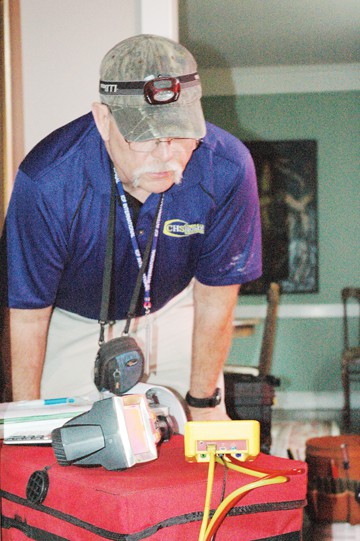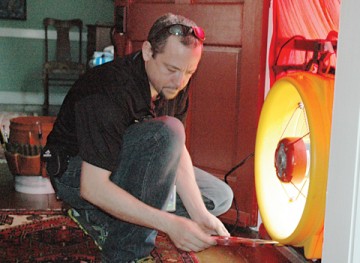My House Is Leaking Money
If the kids left the door ajar with the air-conditioning running, you’d close it. If the windows were open and it grew too chilly, you’d shut them. If a tree crashed through your roof, you’d get it fixed.
So you’d probably be surprised to learn that your home has a gaping hole — or its equivalent, made up of hundreds or even thousands of tiny points of ingress and egress, where air flows in or out.
“It’s like you have a four-foot hole in your wall,” was how Craig Walker explained it to me.
I am by no means alone.
“Most homes, even new ones, are one-and-one-half to four times as leaky as they should be,” said Walker, one of the two technicians from Complete Home Solutions conducting my home energy audit. “If you lived in Hawaii, you wouldn’t care.”
Audited
I’d heard about home energy audits, where trained technicians scour your house for cracks, gaps and all sorts of inefficiencies, pinpointing where your heating, cooling and electricity dollars are going to waste. We’ve upgraded all our appliances to EnergyStar models and we’ve replaced many of our incandescent light bulbs with compact fluorescents, but I still suspected that our 40-something-year-old home might be guilty of more than a few inefficiencies.
| Justin Moore tests the efficiency of the furnace. |
Much if not the entire $400 audit is now paid for by your local utility company.
But like the soil test that our own Bay Gardener regularly urges us to have, I just hadn’t made that energy audit a priority. Some things you get used to living with, like a spotty, weed-ridden yard. Or a house that’s cold and drafty in the winter and hot and oppressive in the summer.
Besides, having lived in older houses all my life — with my current home, built in 1969, the youngest — I’ve always chalked up cold drafts to outdated windows or poorly insulated walls. Without air-conditioning, aren’t all houses in the Mid-Atlantic unbearable during summer?
That’s where Walker and co-worker Justin Moore set me straight. As they explained, most houses are hard to properly heat and cool because of one culprit: air leakage.
In my case, the small but myriad points of ingress and egress were turning my home into a giant fan, pulling in air from below and expelling it above, robbing me of 30 to 40 percent of any heated or cooled air.
The Unseen Culprit
Every home, Walker explained, has a point of neutral pressure. Below that point, cooler air will be drawn in any gaps, while above the neutral point, warmer air escapes through any openings, in a process called conductive looping. Turning up the thermostat only exacerbates the problem, as it increases the flow of warm air, speeding up the process like turning a fan to high.
“A lot of people’s first reaction is more insulation,” Walker said. “But most folks don’t realize that insulation doesn’t stop air.”
“On a windy day, a sweater by itself doesn’t do a very good job of keeping you warm,” Moore elaborated. “But if you put on a layer of something like Under Armour, that stops the air from getting in.”
It’s the same for your home.
“You’ve got to stop air going out and air coming in,” Moore said.
 |
Peeling back a batt of fiberglass insulation from the attic floor, Walker, a retired Prince George’s County firefighter, revealed the evidence of rampant airflow. Where the fiberglass overlapped the framing from the walls below, the underside was plastered with dirt and dust. Yuck!
“A lot of the things we look for as home auditors are things we look for in the fire service, like air flow,” he said.
Cavities between the studs in a wall and the joists of a floor act as natural ducts, Walker explained, channeling air from below up to the top, and providing the path by which fire would spread through a house. In a far less dramatic display, the air flowing through these cavities was wreaking a different kind of havoc every day.
Airflow hit home when Moore attached a red-cowled blower to the front door. Having sealed the house as tightly as possible, he fired up the fan. If a house were perfectly sealed, our ears would have popped in the vacuum. They didn’t.
No house, Walker assured me, is perfectly sealed. “A house doesn’t need to breathe,” he said. “People need to breathe.” So a healthy house exchanges 35 percent of its air each hour.
The blower fan allows energy auditors to extrapolate how much airflow a sealed house allows. Standing before a closed door, I felt a strong flow of air coming from within. At the top of the basement stairs, air came at me as if a fan were directed my way. Even around some door and window frames, I could feel a stirring. As if this weren’t enough, Moore roamed the house with a handheld thermal imaging gun, which displayed even the smallest air breaches in full-colored relief on its small LCD screen.
By the time the fan powered down, I was not surprised to learn that my house was allowing almost three times the ideal airflow.
Getting It Right
Stopping the airflow was first and foremost on Walker and Moore’s list. While the process is pretty straightforward, a matter of caulk, spray foam and weather stripping, it’s more than I would want to take on as a fairly capable weekend warrior. Once the leaks are sealed, they recommend beefing up the insulation from the attic to the basement to the garage ceiling — basically anywhere an inside surface of the house comes into contact with the outside.
What surprised me most was their advice on the attic.
 |
They urged me to think of that unfinished space as the outside. After sealing it off from below and blowing in insulation to more than double its depth, they encouraged me to close it off and more or less abandon the space.
It’s not living space, they explained, and by closing it off, I would be shrinking the space in my home needing heating and cooling. Better yet, with all that insulation, I would be isolating the attic’s extreme temperature swings and keeping that conductive energy from affecting the living space. “Without enough insulation,” Walker said, “your attic in the summer is like a giant radiator.”
In the final report, presented a few days later, my home’s shortcomings were all spelled out, often with accompanying photos, along with the steps to correct the faults. At the end, these suggestions were broken into three differently priced packages, from fixing everything — under $15,000 — to focusing on only the most egregious problems — around $8,000 — to something in between. Of the three bids, all would qualify for a tax credit of 50 percent of the cost up to a total of $2,000.
I haven’t yet decided how to proceed, but the knowledge that I have gained makes the audit a winning experience. For instance, I now understand that even if I spend $50,000 to replace all my windows, as some companies have bid, my house would still be as leaky and cold as before.
Moore had to hunt through the house for lamps and fixtures still using incandescent bulbs, for part of the audit is, he said “replacing up to 12 bulbs with compact fluorescents.” He also installed low-low-flow aerators to any faucets without them, then wrapped the visible hot water pipes. “All this adds up to a value of a couple hundred dollars,” Moore told me
When you add in the rebates and the point-of-service installations, you might think the program was free. But in truth, you and I and every other person with an electric bill in Maryland is already paying for it. As part of the Empower Maryland legislation to reduce energy consumption, every utility bill in Maryland includes an eight- or nine-cent monthly surcharge to underwrite the cost of home audits.
So don’t let your money — or your energy — go to waste. Schedule your own home energy audit.
Complete Home Solutions: 410-286-5564, www.chomesolutions.com.
